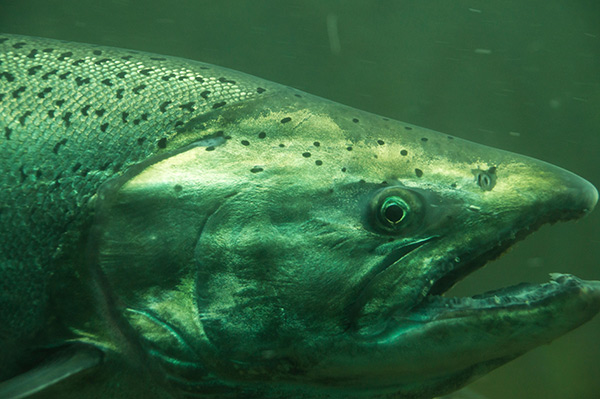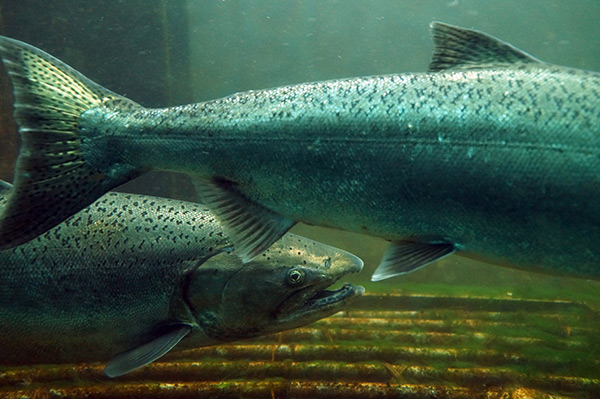Subtotal: $
Checkout
How Do We Steward a Fish?
Salmon and dams have much to teach us about care for creation.
By Derek W. Taylor
August 7, 2023
For countless generations, the native inhabitants of my watershed would gather at the sacred falls of the Spokane River to receive the Creator’s life-sustaining gift of salmon. Early settlers tell of the famous “June Hogs” – Chinook salmon weighing over a hundred pounds – that would migrate up the Columbia River from the Pacific Ocean to reproduce and die in our waters.
In 1939, those June Hogs died not at their spawning grounds but at the base of Grand Coulee Dam. They haven’t returned to the Spokane River since.
Critics have long argued that Christianity is an earth-destroying religion. In response, many earnest defenders of the faith have proffered the notion of stewardship as an ecologically friendly model for the church’s relationship with the environment. The logic of care implied by stewardship is a welcome improvement over the logic of domination. But for me, questions remain. What might stewardship mean in my watershed, where the fish are already gone?

All photographs by Wlodzimierz
Or put more bluntly: How do we steward something we have destroyed? As a theologian and a teacher, I often raise this question in the classroom. It sparks great debate about the value of the environment, our use of it, and our responsibility toward it. But the question isn’t merely theoretical. Not all salmon populations have gone the way of the Spokane. In some watersheds, a small and fragile remnant remains.
The Snake River, another tributary of the Columbia, is the most famous example. Stretching over a thousand miles into the rugged mountains of Idaho and Wyoming, the Snake and its tributaries provide the cold, clean, and protected water necessary for a thriving salmon population. The fish begin their lives in mountain streams before descending to the sea in pursuit of the nutritional abundance they need to grow to their adult size. Then, in an act of breathtaking resiliency and precision that still evades exact scientific explanation, the fish begin to climb back up hill (sometimes gaining over 6,500 feet) to the same stream (sometimes the exact gravel bed) in which they were born. There they reproduce and die, thereby initiating a new cycle of migration and feeding the local ecosystem in the process. Though it was once one of the most productive salmon habitats in the world, the Snake River faces a precarious future. Some predict the fish will be gone within twenty years. Recent proposals outlining a path toward the removal of the four lower Snake River dams, including support from the White House, have added urgency to the question.
Stewarding a River and Its Fish
Experts estimate that when Lewis and Clark floated down the Snake in pursuit of the Pacific Ocean, sixteen million salmon and steelhead returned annually to spawn in the Columbia River basin. Today the number is just a few percent of that – even less if you only count wild fish. Thirteen salmon and steelhead populations in the basin are now listed as threatened or endangered. The reason for their demise, quite simply, is that humans have gotten in the way – literally, in this case. Fish lucky enough to survive the downstream voyage in the Snake River must traverse a series of hydroelectric dams on their journey upstream. Of these dams, four in particular have proven to be the main culprits.
Recent proposals for removing the dams have inspired hope for a healthy river system and a thriving salmon population. They have also aroused vigorous criticism. Besides providing cheap electricity, these dams turn a desert into farmland and convert dangerous rapids into placid slackwater, thereby making Lewison, Idaho – 465 miles from the Pacific – a port for ocean-bound barges. Salmon are important, but so are energy, agriculture, and efficient shipping.
This is one of those intractable questions within environmental ethics that, though fun to discuss in the classroom, proves unwieldly in the real world. So I find myself asking: What might stewardship mean in this case? How do we steward a river and its fish?
Everything Will Live Where the River Goes
In answering this question, my instinct is to turn to the Bible. It begins, after all, with a river, and a river runs through it. The tree of life, hidden from sight since Genesis 3, finally reemerges alongside one in Revelation 22. Ezekiel’s prophetic vision entails a free-flowing river bursting forth from beneath the temple. “When it enters … the sea of stagnant waters, the water will become fresh,” he writes. “Everything will live where the river goes” (Ezek. 47:8–9). It’s hard to imagine the New Creation without also imagining the healing power of fresh, free-flowing water.
For Ezekiel, the river’s healing power lies not only in the quality of its water but in the abundance of its fish. “There will be very many fish,” he suggests, and fishermen will catch “a great many kinds” (Ezek. 47:10). I hear this story echoed at the end of John’s Gospel when Jesus commands his disciples to toss their net on the right side of the boat. John’s oddly precise description of the net’s haul – “it was full of large fish, 153 of them” (John 21:11) – serves to drive home the allusion. Where the resurrected Lord is, Ezekiel’s prophecy comes true. Given the grand arc of the biblical narrative, I can’t imagine the New Creation without fish, and lots of them.
Witnessing to Creation Redeemed
My local watershed has recently witnessed efforts to reintroduce salmon to their native habitat. If the fish are lucky enough to survive turbines, predators, and warm slackwater, a few may make it to the ocean. But few will return. At least not as long as the dams remain. While some of these reintroduction efforts aim to advance salmon research, many are purely symbolic. The pragmatist in me wonders about this. Why go through all the trouble?
The answer came to me last fall as a fly-fishing excursion found me wading through a local stream. Out of nowhere, a thirty-six-inch shadowy shape shot past my legs. In these waters I was used to seeing small rainbow trout and mountain whitefish. I was not used to seeing fish the size of my pet Labrador. When I caught my breath, I realized that the creature was a Chinook salmon a local tribe had ceremoniously released a few weeks earlier.
I recognized in that instant that I had been given a glimpse of the river as it once was and someday could be. If God will indeed renew all things, I was witnessing the river as it someday will be. A bit of the eschaton darted past me that morning.
Out of nowhere, a thirty-six-inch shadowy shape shot past my legs. In these waters, I was not used to seeing fish the size of my pet Labrador.
There is something impractical about symbolic gestures like releasing a salmon that will not survive. Perhaps this is the point. These acts won’t change the world. But they witness to the world as it could be. They remind us that another world is possible. Acts like this prevent me from descending into hopeless despair. Yes, dams are destroying a species. But a Chinook salmon just swam past my legs.
The fish that darted past my legs was raised in a hatchery. So are most salmon in the Snake River and the wider Columbia River watershed. Without the nearly two hundred hatcheries in the region, salmon would likely already have vanished. Hatcheries are the fish’s life-support, human-made contraptions that mimic (expensively and inefficiently) the productive miracle of the natural river system.
Seeing all these fish hatcheries might tempt us to proclaim that we are “protecting” salmon. Official government lingo says we are “managing” them. In reality, we are producing them.
Fragile Yet Resilient
The story of Snake River salmon reminds me of Holmes Rolston’s prescient warning: “Our power to make changes exceeds our power to predict the results, exceeds our power to control even those adverse results we may foresee.” Or said a bit differently, the story of these dams – themselves a product of New Deal optimism – invites us to tap the brakes on the current techno-optimism that believes we can geoengineer our way out of environmental crisis. Human ingenuity has created a problem (dams) that requires more human ingenuity (fish hatcheries), which in turn requires even more human ingenuity (engineered mechanisms to get fish around dams). Who knows what other forms of ingenuity will be required down the road. We are left asking: Will the same spirit that got us into the problem also get us out of it?
I don’t think we can steward our way out of this mess. The logic of stewardship implies that we are agents acting upon an object (the environment) that needs our help. This is a misguided image. What needs help is not the environment but us. Or in theological terms, we – not the earth – are the ones in need of saving. As the Apostle Paul reminds us, the groaning and subjected creation “waits with eager longing for the children of God to be revealed” (Rom. 8:19). Our salvation will be good news for the earth.

Which means it will be good news for salmon. They may not survive our hubristic aspirations. But experience has shown that if we get out of the way, they will come back. If we learn to live within our creaturely limits, the salmon will find a salvation of their own.
When it comes to the four lower Snake River dams, “getting out of the way” is easier said than done. Breeching large dams is a complex task, and an array of stakeholders has voiced opinions. I have no surefire solutions to the tangle of political, economic, and environmental factors that make this debate so challenging.
However, it invites us to consider what this situation reveals about creation and our place within it. Salmon are fragile yet resilient creatures. Without interference, they will thrive. In this way, they stand as a symbol of the earth itself. The earth is fragile yet resilient – fragile in relation to our geomorphic ambitions, resilient because it is God’s. It will thrive if we can learn that God, not humanity, exists at the center of reality.
Its thriving, in other words, does not depend on our stewardship. Its thriving is a gift of God’s grace that we can never create or produce. Yet we have proven we can get in its way. This is the story that Snake River teaches us. Before we can learn how to be stewards we must learn how to be creatures, how to live wisely within the God-given limits of our creaturely form.
Already a subscriber? Sign in
Try 3 months of unlimited access. Start your FREE TRIAL today. Cancel anytime.







Nancy
Thank you for this insightful article about thinking about the environmental issues in a new way.
Patricia Kingsley, MA, MPA, MSE, PhD
I think the way that we rescue something we have nearly destroyed is to love it back into existence, and it is only through mutual love—between us and another of God's relatives—that we will learn to become stewards of each other. When I pray before I eat I thank the foods that are feeding me: I thank the grains that became the flour, and the yeast that made it raise, and the water....I thank the herbs and spices that came from plants, the chickens that laid the eggs, and the cows, that ate the grass, that made the milk, that became the butter that's a part of my meal. The Native American tradition of always thanking a live animal, and asking its forgiveness before taking its life for meat has always been part of the sacred ceremonies and meals that I have been privileged to share in the Southwest. And I think this tradition honors both the life and foods we eat of all our relatives—both the plants and animals--as part of their lives that they give to us, to feed and keep us alive.... So from my perspective, those friends both nurture us and go on living inside our bodies, in ways that can teach us to become good stewards again. And that skill, or awareness, comes through our love for them, and our ways of honoring their lives. My perspective of teaching comes from Paulo Friere's Poverty of the Oppressed, and I believe as he did: if my students are not my teachers, than I have not taught them anything. As a U.S. professor who was one of Friere's own students once said: “We make the road by walking.” Only through our mutual creations and mindful intentions, and by sharing our energy and resources together, can we co-create a different future and learn to live in harmony with all of our relatives together. Having grown up in the Northwest, and spent many summers in Spokane, WA, salmon have always been dear friends to me. When I took the first class co-offered at Riverpointe by WSU and EWSU for Sustainable Building Advisers, the DEQ Adviser, Jim Wavada, said, “we are a part of nature; not apart from it.” And this has always defined how I view ecological perspectives of natural building and regenerative agriculture. These human endeavors should be some kind of a blend between “rewilding,” ecological principles of “stewardship,” and Indigenous wisdom. Having been privileged to know Dr. Gregory Cajete, and used his first book, Look to the Mountain, to shape my perspective of public school education, I believe the greatest source of ecological principles is Native American wisdom, or what Cajete calls: Indigenous Ecology. As Cajete explains in his several books on Native science and education, Native wisdom develops through “an intimate relationship with the plants, the animals, the places in which they have lived,” and this is the wisdom which is preserved in Native languages and "ways of knowing." And this is why I honor Native languages and wisdom because Native wisdom can't be duplicated in modern times. It has evolved through centuries of people who lived in harmony with nature and the lands around them. And those "ways of knowing" cannot be replicated in the logic and deductive frameworks of modern, European languages. This knowledge must be preserved and kept whole in the languages it was first constructed in, in order to be studied and transmitted in the modern world. Which is why I have always argued that: “Cultural diversity is an analogue to biodiversity. If species disappear, you may be able to recover them in the future, but if languages disappear, you loose all the wisdom surrounding those plants and animals that was developed by the people who lived in harmony with their relatives. And at this point in man's “his-story,” it is unlikely that we will ever have more centuries to rediscover what we have lost.” When I took that course in Sustainable Building in Spokane, we also had a class project that required teams to design a children's museum for the Spokane River using LEED architectural principles, and that's where I learned about the “June Hogs” because this stretch of Riverfront Park was also sacred Indian land where Spokane Tribe members would fish for these salmon. So, being of Native blood and believing in the on-the-ground method of observation called, “ground-truthing,” I insisted on walking the ground for the children's museum before I could ever design a museum for it. And when I did, I imagined hatcheries in the warehouses that were still standing there, like those I had seen when I worked on a tribal college project for the Northern Utes, and I imagined cement fish runs with little windows for the children to see the salmon, like those in Boise, that could then go across the property from the hatcheries to release the fingerlings into the Spokane River when Avista opened the floodgates, as they do annually, to raise the water level on Lake Coeur d'Alene because this was part of the river where the June Hogs ran.... Perhaps the June Hogs can no longer come up the river from the ocean because of all of the dams on the Columbia, but at least for however many miles they could run, the fish could swim again in those waters, up and downstream towards the Snake River, as freshwater coho but as their ancestors, the ancient salmon, did. I believe there is a “spirit of place” that persists in time, as Rupert Shedrake has suggested in his theory of “morphic resonance,” and just as we hold a morphic resonance of our own ancestral knowledge in the mitochondria and genetic memory of our cells, so too do I think that other species can hold such genetic memories in their own cells and in their ancestral knowledge of a “place.” And so, this sense of peaceful harmony and resonance that we can feel in nature still permeates in certain places we consider sacred, and protect, and hold dear to us as human beings because the “Spirit dwells” on earth, and I believe this harmonic resonance that we can feel between species who dwell together with the Spirit in sacred places is what we need to study in order to become the stewards we were meant to be.
Kurt
This is a fantastic article. It makes me rethink my perspective on environmental stewardship.